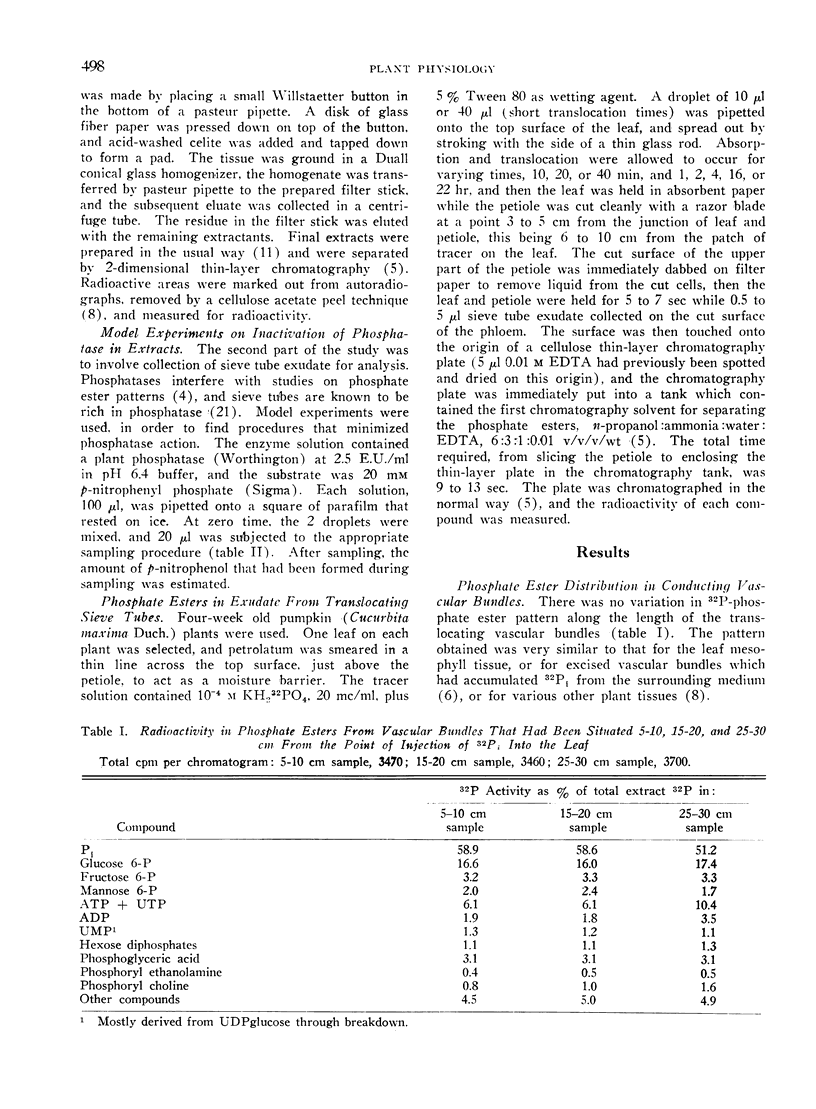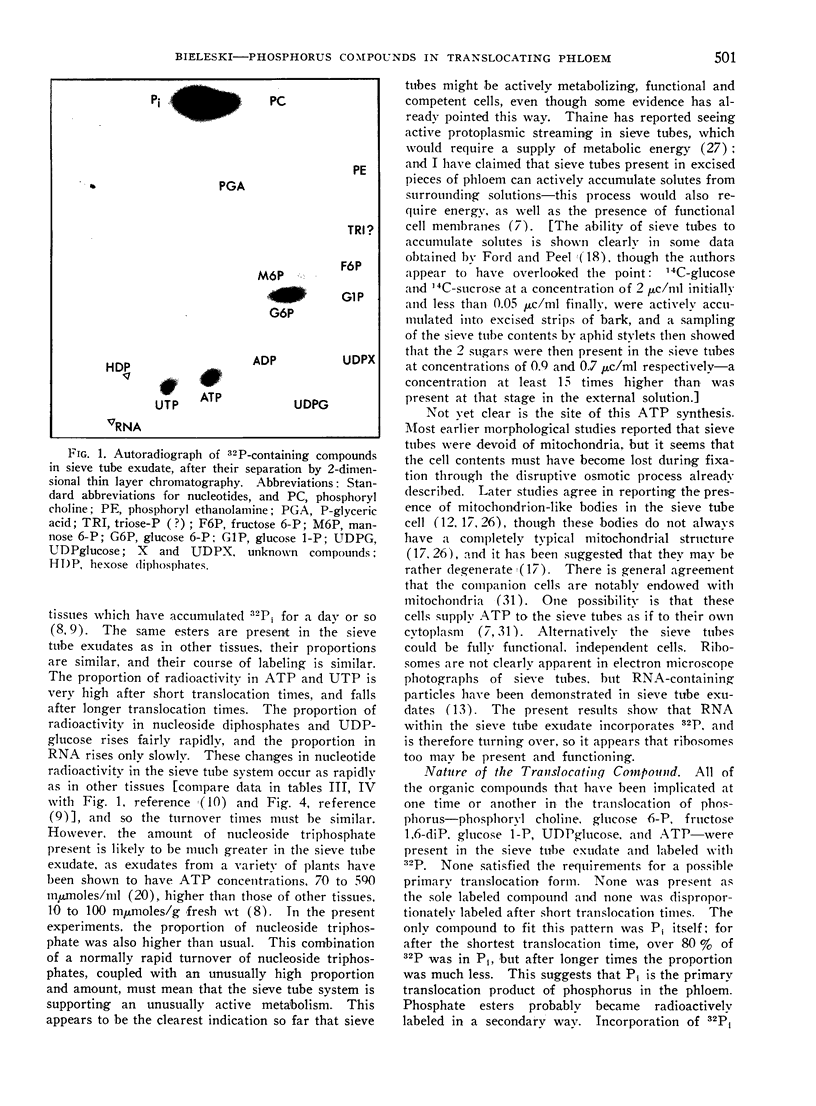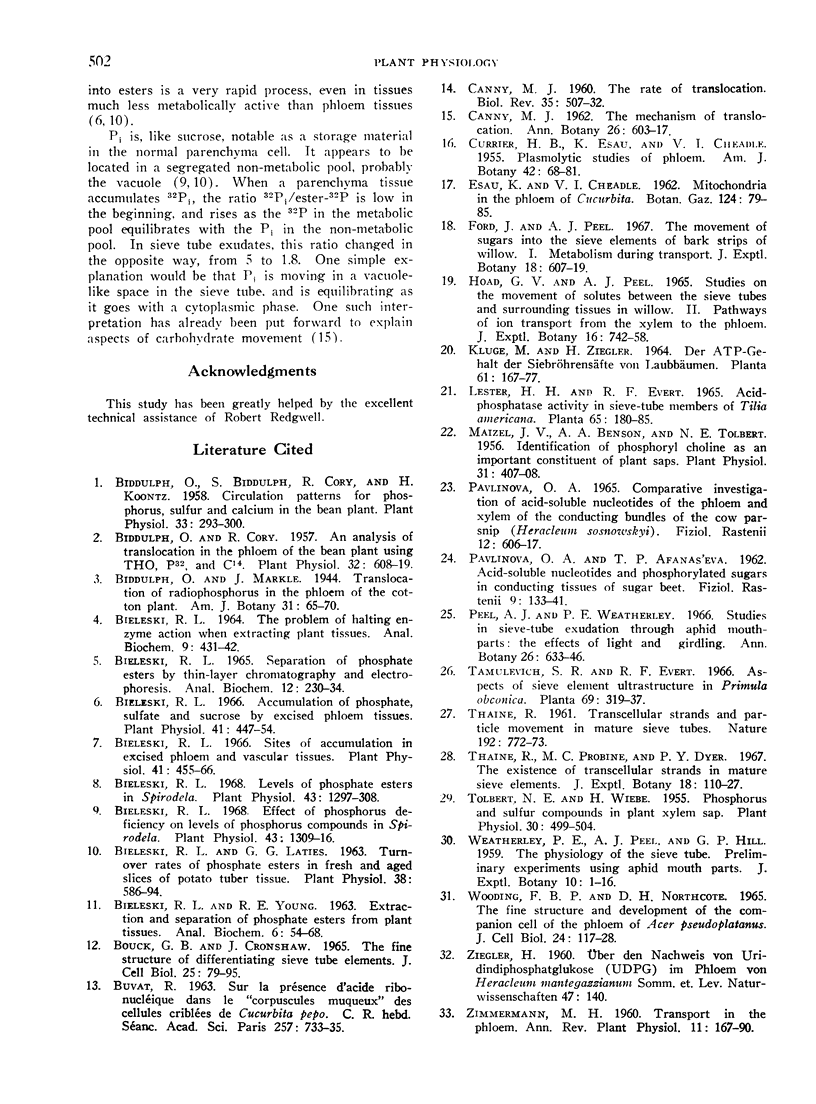Abstract
Phosphate-32P was introduced into a turnip leaf, and 3 hr later, the vascular bundles were stripped from the petiole and their phosphate ester pattern was studied. The pattern did not alter along their length and was like that of other tissues. Pumpkin leaves were painted with phosphate-32P; and later, the petioles were cut, the sieve tube exudates were collected and their phosphate ester patterns were studied. Exudates collected after 10 min had a high proportion of their 32P present in Pi and nucleoside triphosphates, while exudates collected after long translocation times (4-22 hr) had a lower proportion in these, and a higher proportion in hexose monophosphates and UDP glucose. In general, the ester patterns were like those of other tissues. The results indicate that sieve tubes are metabolically active, and that Pi is the primary form in which phosphorus moves in the phloem.
Full text
PDF





Images in this article
Selected References
These references are in PubMed. This may not be the complete list of references from this article.
- BIELESKI R. L. SEPARATION OF PHOSPHATE ESTERS BY THIN-LAYER CHROMATOGRAPHY AND ELECTROPHORESIS. Anal Biochem. 1965 Aug;12:230–234. doi: 10.1016/0003-2697(65)90086-2. [DOI] [PubMed] [Google Scholar]
- BIELESKI R. L. THE PROBLEM OF HALTING ENZYME ACTION WHEN EXTRACTING PLANT TISSUES. Anal Biochem. 1964 Dec;9:431–442. doi: 10.1016/0003-2697(64)90204-0. [DOI] [PubMed] [Google Scholar]
- Biddulph O., Biddulph S., Cory R., Koontz H. Circulation Patterns for Phosphorus, Sulfur and Calcium in the Bean Plant. Plant Physiol. 1958 Jul;33(4):293–300. doi: 10.1104/pp.33.4.293. [DOI] [PMC free article] [PubMed] [Google Scholar]
- Biddulph O., Cory R. An Analysis of Translocation in the Phloem of the Bean Plant Using Tho, P, And C. Plant Physiol. 1957 Nov;32(6):608–619. doi: 10.1104/pp.32.6.608. [DOI] [PMC free article] [PubMed] [Google Scholar]
- Bieleski R. L. Accumulation of phosphate, sulfate and sucrose by excised Phloem tissues. Plant Physiol. 1966 Mar;41(3):447–454. doi: 10.1104/pp.41.3.447. [DOI] [PMC free article] [PubMed] [Google Scholar]
- Bieleski R. L., Laties G. G. Turnover Rates of Phosphate Esters in Fresh and Aged Slices of Potato Tuber Tissue. Plant Physiol. 1963 Sep;38(5):586–594. doi: 10.1104/pp.38.5.586. [DOI] [PMC free article] [PubMed] [Google Scholar]
- Bieleski R. L. Levels of phosphate esters in spirodela. Plant Physiol. 1968 Aug;43(8):1297–1308. doi: 10.1104/pp.43.8.1297. [DOI] [PMC free article] [PubMed] [Google Scholar]
- Bieleski R. L. Sites of accumulation in excised Phloem and vascular tissues. Plant Physiol. 1966 Mar;41(3):455–466. doi: 10.1104/pp.41.3.455. [DOI] [PMC free article] [PubMed] [Google Scholar]
- CANNY M. J. The rate of translocation. Biol Rev Camb Philos Soc. 1960 Nov;35:507–532. doi: 10.1111/j.1469-185x.1960.tb01525.x. [DOI] [PubMed] [Google Scholar]
- MOLE BAJER J. TELOPHASE SEGREGATION OF CHROMOSOMES AND AMITOSIS. J Cell Biol. 1965 Apr;25:SUPPL–SUPPL:93. doi: 10.1083/jcb.25.1.79. [DOI] [PMC free article] [PubMed] [Google Scholar]
- Maizel J. V., Benson A. A., Tolbert N. E. Identification of Phosphoryl Choline as an Important Constituent of Plant Sap. Plant Physiol. 1956 Sep;31(5):407–408. doi: 10.1104/pp.31.5.407. [DOI] [PMC free article] [PubMed] [Google Scholar]
- Tolbert N. E., Wiebe H. Phosphorus and Sulfur Compounds in Plant Xylem Sap. Plant Physiol. 1955 Nov;30(6):499–504. doi: 10.1104/pp.30.6.499. [DOI] [PMC free article] [PubMed] [Google Scholar]



